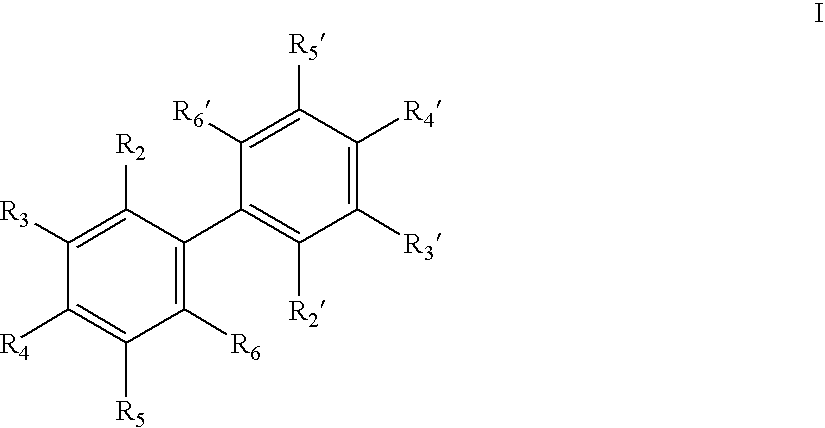Antiandrogenic biphenyls
a technology of antiandrogenic biphenyls and biphenyls, which is applied in the field of antiandrogenic biphenyls, can solve the problems of not having the affinity of receptors as good as steroidal antiandrogens, unsatisfactory activation of receptors, and lack of undesirable androgenic activity of non-steroidal antiandrogens such as flutamide, casodex and anandron
- Summary
- Abstract
- Description
- Claims
- Application Information
AI Technical Summary
Problems solved by technology
Method used
Image
Examples
example 1
[0136] Example 1 is a general scheme of some preferred biphenyls of the invention using as key step a Suzuki coupling. 149
example 2
Synthesis of 4'-Cyano-4-fluoro-3'-trifluoromethyl-biphenyl-2-carboxylic acid amide (EM-4171)
[0137] 4-Bromo-2-trifluoromethylbenzonitrile:
[0138] In a round bottom flask, 4-cyano-3-trifluoromethylaniline (20 g, 107.5 mmol) was solubilized in 300 mL of 47% aq HBr. This solution was cooled to 0.degree. C. in an ice bath and NaNO.sub.2 (22.2 g, 322 mmol) was added slowly. Then CuBr (46.3 g, 322.5 mmol) was added slowly. After the addition, the ice bath was removed and the mixture was stirred at 20.degree. C. for 3 hr. The mixture was cooled to 0.degree. C. in an ice bath and 500 mL of water were added to get a yellow precipitate. Solid was filtered and washed successively with 10% aq. HCl (50 mL) and water (100 mL), and dried to give the product (23.5 g, 87%), .sup.1H NMR (300 MHz, Acetone-d.sub.6).delta.: 8.19 (s, 1H, C.sub.3--H), 8.16 (d, 1H, J=8 Hz, C.sub.6--H), 8.05 (d, 1H, J=8 Hz, C.sub.5--H).
[0139] 4-Fluoro-2-methoxyphenylboronic Acid:
[0140] In a round bottom flask dried under argo...
example 3
Synthesis of 3-chloro-2',4'-difluoro-biphenyl-4-carbonitrile (EM-4283)
[0152] 3-Chloro-2',4'-difluorobiphenyl-4-carbonitrile (EM-4283):
[0153] In a round bottom flask, 4-bromo-2-chlorobenzonitrile (3 g, 13.85 mmol), 2,4-difluorophenylboronic acid (2.63 g, 16.63 mmol) and K.sub.3PO.sub.4 (8.83 g, 41.56 mmol) were added in dry DMF (50 mL). The mixture was purged under argon for 30 min and Pd(PPh.sub.3).sub.4 (1.6 g, 1.38 mmol) was added. The mixture was heated for 48 hr at 80 C. Water (100 mL) was added and the aq layer was extracted with CH.sub.2Cl.sub.2( 3.times.50 mL). The organic layer was washed with brine (3.times.50 mL), dried, evaporated and purified on silica gel (EtOAc / hexanes:1 / 19) to give the product (1 g, 29%), .sup.1H.NMR (acetone-d.sub.6) .delta.: 7.2-7.28 (m, 2H), 7.72-7.79 (m, 2H), 7.91 (t, 1H, J=1.4 Hz), 8.02 (d, 1H, J=8.1 Hz).
PUM
| Property | Measurement | Unit |
|---|---|---|
| concentration | aaaaa | aaaaa |
| concentration | aaaaa | aaaaa |
| concentration | aaaaa | aaaaa |
Abstract
Description
Claims
Application Information
 Login to View More
Login to View More - R&D
- Intellectual Property
- Life Sciences
- Materials
- Tech Scout
- Unparalleled Data Quality
- Higher Quality Content
- 60% Fewer Hallucinations
Browse by: Latest US Patents, China's latest patents, Technical Efficacy Thesaurus, Application Domain, Technology Topic, Popular Technical Reports.
© 2025 PatSnap. All rights reserved.Legal|Privacy policy|Modern Slavery Act Transparency Statement|Sitemap|About US| Contact US: help@patsnap.com



